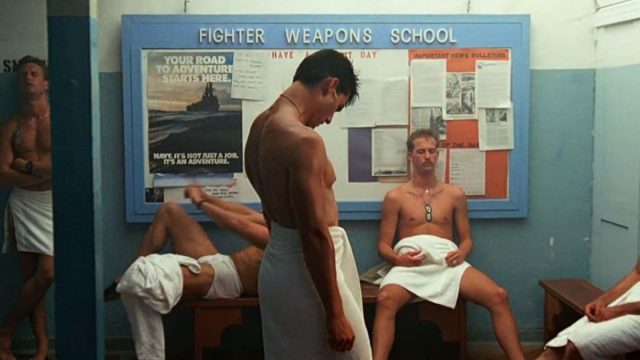The FAR has been ogling you from across the room. You’re one of our types: a felt pig, a sexy AF Tig, an actor-turned-director, a strikingly edited video, a gay fighter pilot.
Thanks to scb0121 for turning our head this week. Send articles throughout the week to ploughmanplods [at] gmail, post articles from the past week below for discussion, and Have a Happy Friday!
Slate‘s Matthew Dessem chronicles the offscreen romance between the late Charles Grodin and Miss Piggy:
But when word broke out that real sparks were flying between Grodin and Miss Piggy on set, the world was captivated at the thought of a tinseltown romance between the suave star of The Young Marrieds and the inanimate block of foam rubber from The Muppet Show. Grodin carried out part of his courtship in the press, first letting it be known that he was unhappy with the script, telling a reporter that “losing Miss Piggy to Kermit is hitting rock bottom.” Before long, he was rhapsodizing about his co-star to anyone who would listen, repeating variations of this line in a passel of interviews: “Miss Piggy and I have a real love scene in the picture. She’s just my type—available and unavailable, coy, flirtatious, and humorous. She has a flair. She’s unpredictable. And she’s pink, and that’s always nice.”
At Vox, an inventory of the 25 editing techniques popularized by Internet video, where they find their roots, and what they contribute to the vocabulary of motion pictures:
Comedian Atsuko Okatsuka once summarized her Twitter video style as “Okay, here’s the weird part. Good-bye.” It’s a perfect description for the videos, now common across Twitter, TikTok, and Instagram, in which the clip ends right as the action hits. That feeling of What the hell did I just watch overlaps with Well, I simply have to watch that again — a winning combination for both creator and audience. “Back at it again at Krispy Kreme,” a micro-video from Vine, is the platonic ideal of this technique, which was popularized on the late app. In the clip, a guy holds up a Krispy Kreme hat to the camera; says, “Back at it again at Krispy Kreme”; and does a back handspring, knocking a sign off the wall. Except you don’t really see the sign fall off the wall. You see the handspring and the initial crash of body and neon and then black. That’s all you get. It’s impossible not to watch it again.
For The AV Club, Danette Chavez interviews Tig Notaro about her role in Army of the Dead, shifting between creative control and acting, and improvising on set:
I really don’t improvise too much when I go on to somebody else’s project. I’m typically taking on the project because I like it and I like what they’ve done. There might be a word or a line a little bit here and there that I might adjust, but it’s typically very minimal. I’ve heard people say, “Oh, I can tell you were riffing on Star Trek,” and I’m like, “No. No, I’m not. Somebody wrote that for me and they did a really great job.” It’s not my go-to to show up on a TV show or movie and just say, “Hey, I’d like to kind of go nuts here. I’m going to riff a bit.” If it comes up organically in a scene, or the director encourages us to, or my scene partner is going off, maybe something will happen. But I typically just try to learn my lines and do what they wrote.
Craig J. Clark runs down the directing credits of Steve Buscemi at Crooked Marquee:
Role models of any kind aren’t easy to come by in 2005’s Lonesome Jim, by far the most conventional of Buscemi’s features. Like Trees Lounge and Animal Factory before it, it’s inspired by the life experiences of its author, James C. Strouse, who lent his name and family’s Indiana ladder factory to sad-sack protagonist Jim, a depressed washout at 27 played by Casey Affleck. Returning to his insular hometown just after Christmas (which he likely missed on purpose), Jim slips back into old routines with his parents (Mary Kay Place and Seymour Cassel) and older brother (Kevin Corrigan), who precipitates the first of many family crises when he drives into a tree and ends up in a coma. The rest of their misfortunes can be traced to Jim’s scumbag uncle (Mark Boone Junior), who’s using the factory as a front for drug deals. (That’s another theme that runs through Buscemi’s films: the general availability and casual use of hard drugs.) If not for the love of a good woman (specifically, a nurse played by Liv Tyler) and admiration of her adorable moppet of a son, Jim’s lonesomeness would surely be incurable.
Chris Lee at Vulture talks to Jerry Bruckheimer about Top Gun‘s homoerotic reputation and confirms a Tony Scott legend about the filming:
[Scott] wanted it backlit when they were taking off and landing, and they were turning [the aircraft carrier] so it was the front. But Tony said, “It’s going to look ugly. You’re not going to want it this way.” And the admiral said, “Look, we have to conserve fuel. You only have X amount of fuel when you go on these cruises.” And Tony said, “How much will it cost?” He said, “Around $10,000.” He pulled out his checkbook and gave him a check.
And finally, for handy reference or just for that empty spot on your wall, a visual representation of every coffee consumed in Twin Peaks during the show (by Judit Bekker via Tableau Public):
These are all the 258 damn good coffees consumed in Twin Peaks over 3 seasons and 25 years. The biggest caffeine addicts were Cooper and Harry. The local police station and RR are in close competition for the no. 1 coffee place of Twin Peaks title.

